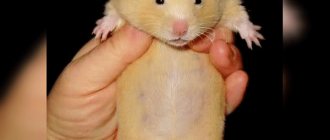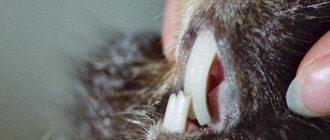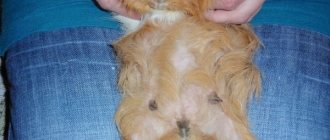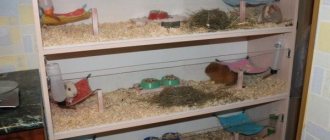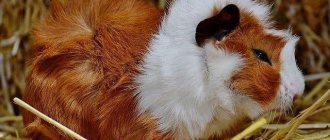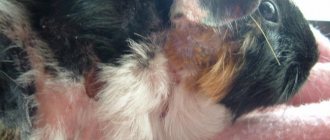A pregnant guinea pig is under severe stress because pregnancy is a complex process with many risks. The pet's appearance and behavior change. You need to be prepared for this and react correctly to changes, because the animal is completely dependent on the owner, whose duty is to provide the necessary help.
Signs of pregnancy
The earliest symptom of pregnancy is the absence of another heat cycle. In addition, you can see with the naked eye that the rodent’s belly has increased in size.
At the 3rd week of gestation, the female’s genitals become loose and increase in size.
Due to hormonal changes in a pregnant guinea pig, small cracks often appear on the skin, which need to be lubricated with baby cream without any fragrances.
If you pick up the animal and try to palpate the abdomen, you can feel small lumps. At the 4th week, you can determine how many fruits the female is carrying, since at this stage they can already be clearly felt. The pig does not like such manipulations, and it may begin to break free and bite. As soon as the pet begins to show dissatisfaction, it should be immediately put back in the cage. Particular care should be taken when pressing on the rodent's abdomen in late stages of gestation, as this can provoke early termination of pregnancy.
Starting from the 4th week, the animal begins to quickly gain weight. When this is not observed, you should show the rodent to a veterinarian.
At the 6th week, the animal becomes less mobile and sleeps most of the day. Watching a pregnant pig during this period, you can notice how the cubs move.
How long pregnancy lasts in guinea pigs depends on the breed, size of the rodent and the number of fetuses. On average, it lasts 64 days, but when the female carries only 1-2 cubs, she can be pregnant for 75 days, and when there are many fruits, the period is reduced, and childbirth can occur on 58-62 days.
It is better if a pregnant guinea pig is separated from other rodents, because:
At what age do they give birth and how often?
These animals reach sexual maturity at a fairly early age. If we talk about the first mating, the best age is considered to be from 4 to 6 months.
The average duration of estrus is 16 days, but it should be borne in mind that there is a certain time period when the guinea pig is ready to mate and its duration is only 8 hours.
A female gives birth to 2-4 cubs. But soon she may again go into heat, in which she can also mate. Therefore, having cubs and feeding them, she may be pregnant with other offspring.
Baby care
After the guinea pig has given birth, there is nothing special for a person to do, since the mother herself is capable of caring for the offspring. Usually 1 to 5 cubs are born. Their weight is about 50-100 g (it all depends on the size of the litter), they are covered with hairs, have teeth, their eyes are open and in just a few minutes they can move independently.
The female has only two nipples, but they are quite enough to feed all the offspring - the newborns suckle in turns. From the third day, babies begin to try food for adult animals.
If for some reason the pig refuses to feed the babies or she does not have milk, the cubs are transferred to artificial feeding or placed with another mother. Before this, the piglet’s fur is wiped with sawdust taken from the stepmother’s cage so that the latter can better accept the foundling.
You can also raise offspring using artificial feeding. To do this, newborns are administered 1 cc using a pipette. see baby formula every two hours for a week. They are also given hay and green food.
Do not forget to stimulate defecation and urination in orphans using a cotton pad, which is used to irritate the anal area.
Complications during childbirth
Usually childbirth is easy, but there are a number of cases when the help of a breeder and even a veterinarian may be required. Every guinea pig owner must know what to do in case of complications during childbirth and how to recognize life-threatening situations for the animal.
The most important thing is that the female’s birth canal should be completely open by the time labor begins. If the birth canal is open, the female has been pushing for a long time, but the cubs have not been born, she looks tired and depressed - you should immediately call the veterinarian. Most often, this situation requires surgical intervention.
Most often, complications during childbirth are caused by toxicosis during pregnancy. Toxicosis not only weakens the guinea pig's body, but leads to the death of babies. If toxicosis does not go away until birth, this can lead to the death of the female.
Another common cause of difficult births is the baby getting stuck in the birth canal. This can happen because the fetus is very large or the female is too old and her hip joint has lost mobility. You can identify a stuck fruit by the following signs:
- the female pushes for fifteen to twenty minutes, but the fetus does not come out,
- looks worried
- bites his sides.
In this situation, it will no longer be possible to save the fetus, but you can still help the female.
To do this, you should wash your hands well and examine the inside of the animal’s vagina with your finger. If the fetal head is detected, it should be squeezed with your fingers and gently pulled. It is better to do this simultaneously with the female’s attempts.
If a female once had complications of any nature during childbirth, then there is a high risk of their recurrence. The owner of a purebred animal or an animal of a rare color is more likely to risk re-coating, but in this case, during the next birth, the presence of a veterinarian is required. If the pig is outbred or is not of particular value, you should refrain from further producing offspring.
Selection of animals for breeding
To get strong, healthier offspring, you need to wisely select a pair for your rodent. Only clinically healthy animals are allowed for breeding. Guinea pigs must meet the following parameters:
- be active, mobile;
- have beautiful shiny fur, clear eyes;
- be moderately well-fed;
- have excellent breed qualities.
Animals suffering from obesity, chronic, congenital pathologies, defects, exhausted, sick rodents are not suitable for breeding. The weight of the female before mating should not be less than 700 grams. The expectant mother must be absolutely healthy and in excellent physical shape.
It is also not recommended to mate females who have not given birth and are older than one year, since the ligaments lose elasticity and the birth of a guinea pig can end in failure.
In order for the offspring to be born strong, healthy, and viable, female guinea pigs should not give birth more than twice a year. Males can be bred 2–4 times a year. In case of uncontrolled use of males, females will remain uncovered.
The best period for breeding guinea pigs is mid-spring and early summer. At this time there is a lot of varied and healthy food for rodents.
A week before the planned mating, you need to supplement the rodents’ diet with food that is rich in proteins, essential amino acids, vitamins A, E, C. Feed the pig sprouted wheat and high-quality cereals. Supplement your diet with succulent food, herbs, vegetables, and fresh hay.
Development of newborn guinea pigs by day
Pig cubs are born sighted, hearing and covered with hair. Their further development consists of increasing body size and strengthening the body.
Piglets grow very quickly. For the first time, weight increases on the second day - by 1 gram. Starting from the third day, the increase is 3–4 grams per day. Two weeks later, the animals weigh twice as much as at birth. Rapid growth continues until 7–8 weeks, after which it slows down. Normal weight at this age is about 0.4 kg.
Full formation of the body lasts up to 15 months. An individual is considered an adult from 6 months, when the male reaches 900–1200 g, and the female 500–700 g.
Puberty in rodents
An early first pregnancy is dangerous for a guinea pig. Although the female is ready to reproduce at the age of 2 months, her body is not yet strong enough to bear offspring and give birth to healthy cubs.
Veterinarians recommend waiting until the first mating. The ideal age to get pregnant for the first time is 11-12 months. Until this point, different-sex individuals are kept in different cages.
In males, puberty occurs 1-2 weeks later. At this age, the animal’s weight is 700-800 g.
Signs and preparation for impending birth in a guinea pig
The owner calculates the approximate date of birth in advance (or consults a specialist) in order to monitor the process and provide assistance at the right time. Closer to the desired date, a nesting house is set up in the cage. You can use a regular box, lining the bottom with sawdust, hay, pieces of fabric or newspaper.
When the gestation period comes to an end, the female shows restlessness: she builds a nest and constantly washes herself. As a result, mobility decreases. She sits motionless next to the nest and consumes a lot of water.
The proximity of birth is determined by examining the pig's pelvis: after the 60th day of pregnancy, the pelvic joints will begin to expand and the birth canal will open. A dilatation of approximately 2 fingers wide means that birth will occur in the next 24 hours. During this period, the animal experiences increased thirst, accompanied by a refusal to eat.
As a special precaution, owners prepare in advance everything they need in case of a pathological birth: clean towels, milk replacer, disposable syringes.
Behavior change
If you know your pet well and have often observed it, then you will notice changes in behavior immediately. The female moves less, one might say that she becomes lazy.
She tries to build herself a separate house, looks for a secluded corner and buries herself in the hay. Refusal of any treats may also occur. Can show aggression towards the male sex.
How to care for offspring
If you decide to breed guinea pigs, then it is worth remembering that after the female gives birth, you can pick up the piglets only as a last resort. The mother handles everything else herself and does not require human intervention. Up to five babies are born in a litter, who already have teeth and open eyes, and after an hour the offspring begin to move independently.
The pig has two nipples and the babies take turns sucking milk. If the mother has abandoned the litter, then it is worth transferring the young to another mother. In order for the female to accept the offspring, the fur must be wiped with bedding taken from the nest of the new teacher. In the case of artificial feeding, the procedure is carried out every 120 minutes using a pipette and a special milk mixture.
72 hours after birth, the animals are already trying adult food. Breastfeeding lasts three weeks, after which lactation gradually decreases, and the mother loses interest in the offspring. Young animals are allowed to be placed in a separate cage at the age of 30 days.
Birth injuries and weakened puppies
If 2–3 puppies are born, perhaps some of them are weak. For example, a puppy is born in the membranes. The baby cannot get rid of the shell on his own, and the mother chinchilla is busy giving birth to the next chinchilla and is not distracted to help him. Help the puppy yourself - grab the membrane with your nails and remove it from the baby’s face and body. Use a cotton swab to clear amniotic fluid from your mouth. Then perform artificial respiration: in the “standing on your paws” position, bend and straighten the baby’s body several times to open the lungs. Open your eyelids and wipe your eyes with a cotton swab. Warm and dry the newborn in your palms or in a towel. Do this work for the chinchilla mother, who is currently busy giving birth to her next baby.
During prolonged labor, when the fetus comes out with difficulty, the chinchilla helps itself and pulls out the fetus, grabbing it with its teeth. If the fetus moves head first, the female pulls it by the neck. If the fetus comes out in the wrong position with its legs forward, the woman in labor pulls it out by grabbing the legs or tail. A chinchilla gets damaged from the female's teeth. Lubricate wounds on a newborn with a healing ointment, such as Levomikol. Sometimes birth injuries lead to death or disability in newborns.
How to tell if your guinea pig is pregnant?
- A pregnant pig begins to gain weight after about 5 weeks.
- Weighing yourself regularly with records can help you detect pregnancy early.
- In case of regular weight gain (of course, if the pig is not prone to weight gain), you can start expecting babies.
- In the last few weeks, the tummy should become increasingly tight and noticeably increase in size;
Expert opinion
Nastya Shulepina
I love helping animals and writing about them. Veterinary resuscitator.
Ask a Question
If the pig is large and carries only one child, even an experienced breeder can miss the pregnancy (this happened to a friend). So remember that the only sure way to determine if your guinea pig is pregnant is to get an ultrasound from your veterinarian.
Let's sum it up
Guinea pigs are very affectionate and wonderful animals that become family pets. Of course, breeding them is very interesting and exciting, but you should always remember that this is not at all easy, think about whether you should do it.
Here a person takes responsibility for the animal and its offspring, and the breeding process itself is very labor-intensive. You will need to study a lot of information and prepare properly so that no difficulties arise.
Complications during childbirth
Typically, giving birth to a guinea pig does not require much assistance from the owner.
If signs of complications or pathology appear, you should contact your veterinarian:
- the female makes efforts for fifteen minutes, but there is no calf;
- contractions last more than an hour;
- the animal makes too intense screams;
- severe bleeding began;
- there is profuse drooling or foaming at the mouth;
- the fetus gets stuck in the birth canal or goes backwards.
Possible problems
Despite the naturalness of this process, which should be inherent in any female animal, some complications may arise during and after childbirth:
- The youth of the female. Pigs can be used for breeding when they have reached a weight of 500 g. However, quite often females purchased from pet stores that live in the same cages with males may already be pregnant. However, if they are small, they are not able to give birth and raise offspring on their own.
- The female refuses to rupture the membranes of newborns. If this is not done in time, the babies may suffocate. The owner must help by tearing the film around the muzzle and clearing the mucus from the mouth and nose. To restore breathing, the baby is held tightly in the hand and shaken vigorously. They are then dried with a soft cloth and placed close to a heat source, such as a bottle of warm water. An hour later, when he can move, he is placed next to his mother.
- Termination of labor. If the uterine contractions have stopped, and there are still fetuses in the uterus, it is imperative to take the female to a veterinarian. He will help you surgically remove them.
- Refusal to breastfeed. This happens quite rarely, but nothing can be done. In this situation, children will need to be artificially fed.
- Shy female. Sometimes females can be frightened of their children, even though she has already partially licked them. She screams loudly and runs away, but since the babies are cold, they follow their mother, scaring her even more. If nothing is done, they will die from hypothermia. In this situation, you need to remove the babies, and after a while start adding them one at a time, giving the mother time to sniff them. If all else fails, then the owner needs to feed.
- Lack of milk. A young female may not have enough milk to produce a litter that is too large. In this case, you need to find another female or help the animal do this. The most suitable milk composition is pig milk. To obtain additional energy, honey and vitamin drops are added to it.
As you can see, caring for a pregnant guinea pig is not difficult, but it has its own nuances. Knowing them, you can carry out childbirth without problems and also provide the necessary care for the offspring and the female.
Signs of pregnancy in guinea pigs
The first thing you notice when a guinea pig is pregnant is a change in its usual behavior. A pregnant animal becomes less mobile and tries to hide in its house or in the corner of its cage.
It is also possible to show aggression towards their relatives and, especially, towards the male. In addition, there are a number of other signs, such as:
- Changes in your guinea pig's appetite. As a rule, during pregnancy, the female's appetite increases, and accordingly, she requires more food. But sometimes it happens the other way around - a guinea pig may refuse its favorite food completely or go through the food.
- Stomach. One of the obvious signs of pregnancy is an enlarged abdomen in the animal. The growth of fetuses in guinea pigs occurs quite quickly, and a strong increase can be noticed already from the third week. After seven weeks of pregnancy, you can see the movement of the fetuses in the abdomen of the animal.
- Weight. It follows from the previous sign. During pregnancy, the pig gains weight due to increased food intake and fetal growth. A noticeable weight gain during pregnancy can be observed as early as the fourth week. As birth approaches, the animal's weight may double its original weight.
- Estrus. Typically, estrus occurs once every two weeks. During estrus, the guinea pig arches its back and makes a characteristic rumbling sound when stroked. The approximate duration of estrus is about a day, during which time the animal’s vagina is swollen and moist. During pregnancy, there is no estrus, and changes in the external genitalia also occur: they become loose, swell, which is why their size increases.
- Toilet. Due to the growth of the fetus, the uterus begins to compress the animal’s intestines and bladder, resulting in an increase in the number of acts of defecation and urination.
Features of feeding a guinea pig during pregnancy
When caring for a guinea pig during pregnancy, it is necessary to pay sufficient attention to the feeding process. Carefully monitor the cleanliness of feeders and drinkers (it is recommended to wash them at least twice a week), as well as the amount of food.
During pregnancy, it is necessary to increase the amount of food for the animal by two times, and by the end of pregnancy - three times.
For feeding, you should use both classic versions of food for rodents, hay, and:
- fresh vegetables and herbs;
- special granulated food for pregnant rodents;
- milk;
- cottage cheese.
After the birth of the cubs, the female experiences thirst for some time, so it is necessary to ensure that there is always fresh water in the drinking bowl. It will also be useful to give the animal juicy fruits.
If a guinea pig refuses to eat after giving birth, it is necessary to show the animal to a veterinarian. Possible causes of lack of appetite include the development of endometritis, which can lead to the death of the animal.
Weight gain
Of course, your beloved pet will gain weight; by the time she gives birth, the female will double her weight. It is recommended to regularly weigh the expectant mother and record her weight to monitor her normal condition.
When weighing, you need to be as careful as possible so as not to harm either the pet or the fetus; carry them very carefully.

